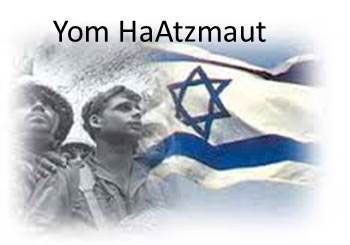
Yom Ha’Atzmaut
Israel’s Independence Day is celebrated on the fifth day of the month of Iyar, which is the Hebrew date of the formal establishment of the State of Israel, when members of the “provisional government” read and signed a Declaration of Independence in Tel Aviv. This year, Yom Ha’atzmaut begins on MAY 5 and ends on the 6th. In Israel it’s a formal holiday.
Yom Ha’atzmaut in Israel is always preceded by Yom Hazikaron, Israel’s Memorial Day for fallen soldiers. The message of linking these two days is clear: Israelis owe their independence—the very existence of the state—to the soldiers who sacrificed their lives for it.
The official “switch” from Yom Hazikaron to Yom Ha’atzmaut takes place a few minutes after sundown, with a ceremony on Mount Herzl in Jerusalem in which the flag is raised from half staff to the top of the pole. The president of Israel delivers a speech of congratulations, and soldiers representing the army, navy, and air force parade with their flags. In recent decades this small-scale parade has replaced the large-scale daytime parade, which was the main event during the 1950s and ‘60s. The evening parade is followed by a torch lighting (hadlakat masuot) ceremony, which marks the country’s achievements in all spheres of life.
Other than the official ceremonies, Israelis celebrate Yom Ha’atzmaut in a variety of ways. Many spend the night dancing Israeli folk dances and singing Israeli songs. During the daytime thousands of Israeli families go out on hikes and picnics. Army camps are open for civilians to visit and to display the recent technological achievements of the Israeli Defense Forces.
Yom Ha’atzmaut is concluded with the ceremony of granting the “Israel Prize” recognizing individual Israelis for their unique contributions to the country’s culture, science, arts, and the humanities.
The religious character of Yom Ha’atzmaut is still in the process of formation, and is still subject to debate. The Chief Rabbinate of the State (which consists of Orthodox rabbis) has decided that this day should be marked with the recital of Hallel (psalms of praise), similar to other joyous holidays, and with the reading of a special haftarah.
Some rabbis argue that Yom Ha’atzmaut should be viewed in conjunction with Hanukkah and Purim, since all three commemorate a “miraculous” victory for the Jews over an enemy of superior military might.
For American Jews, celebrating Yom Ha’atzmaut has been a way to express solidarity with the State of Israel. In many North American congregations, the joint public celebration often is augmented by a religious service. In some cases, this would occur on the Shabbat closest to Yom Ha’atzmaut and would consist of additional readings added to the service and, usually, the singing of Hatikvah (the Israeli national anthem).
There is not yet an accepted “tradition” of how to celebrate this holiday, and only time will tell whether certain customs, foods, prayers, and melodies will be linked in the Jewish mind with this holiday, as with holidays that emerged many centuries before For Jews around the world, joining with Israelis celebrating Yom Ha’atzmaut has become a concrete link in the Jewish connection to the land of Israel.



